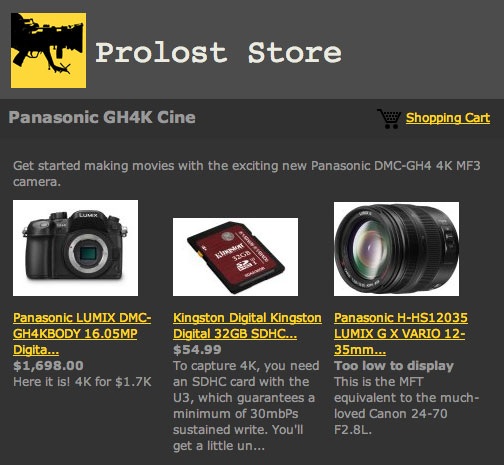
As the comment count approached 100 on my last post, Jim Jannard sent me a note asking if he could explain some of the less obvious aspects of the new RED product line. It turns out that Jim has a complex, nuanced vision for how people will use these cameras, and he was eager to explain it to someone who might grok it.
Without trying to speak for Jim, his basic message was that he is indeed making the camera I'm asking for—just not at the price I was hoping for.
The secret lies in the format chart that he posted late last week, the one that details the various windowing options for the various brains. Jim's vision is that these windowing options represent not just a way for us to compromise field of view for frames-per-second, but in fact a way for filmmakers to design their own formats, project by project.
For example, on the Epic S35, one could design a project around PL-mount lenses that might porthole noticeably at the full 5K width, which is wider than Super 35. But window in to 4K and you're basically shooting with the RED One, except you've got better dynamic range and up to 115 fps.
On the Epic FF35, you could define exactly the 4K window with your vast sensor that would capture an Academy-sized image and shoot with anamorphic lenses. This would be different than the 4K window you'd shoot to for a 2:35 center crop with spherical PL-mount lenses. And the next day you could be shooting 6K using every millimeter of your Canon L-series.

When you look at it this way, Jim's building blocks offer a dizzying number of options, more even than was clear at first glance. It's a ton of rope, well more than enough to hang oneself (the post options just got officially redonkulous), but also pretty freaking cool. Owner-operators will be able to dial in custom crops that make the most of their glass, and play with the relationship between over-the-top resolution, FOV, and slow-mo capability. Jim called it "elbow room"—the excessive resolutions and slightly-bigger-than-standard gates are designed not to become new standards as much as to encompass a perpetual choice of existing ones.
 This diagram is mine, not RED's, and is just guesswork and supposition and therefore probably completely wrong. Stop looking at it already!
This diagram is mine, not RED's, and is just guesswork and supposition and therefore probably completely wrong. Stop looking at it already!
Jim's perspective was that he had indeed offered the camera I want. The Epic S35, windowed to 4K, is a cinema-sized sensor that takes cinema and DLSR lenses and offers frame rates up to 115 fps.
It's also $28,000 without ports, batteries, or recording media.
To my way of thinking, the camera features most important to a filmmaker are sensor size, dynamic range, and maximum frame rate. Images should look good projected in a theater and on HD—anything more gets into specialty territory.
To me, the sweet spot that addresses all of these, that matches the film cameras that owner-operators prize for flexibility, would be a 3K super-35 sensor that went up to 72fps. My feeling is that within the panoply of RED's offerings, this sweet spot, were it to exist, aught to be at the affordable end of things. I know big chips cost exponentially more than small, and I do expect to pay for that size, but my size/cost-ometer has been irrevocably jangled by the Canon 5D MarkII—legitimately or not. Canon sells me a VistaVision sensor with LCD and electronics for $2500. I dared to hope that RED could sell me a sensor half that size with 1/4 the pixels for maybe twice as much—without LCD, battery, or recording mechanism.
Did RED miss a filmmaking sweet spot? Only if you, like me, hoped that part of "killing" DSLRs meant getting anywhere near their price range.
Jim certainly opened my eyes to a jaw-droppingly deep array of options and flexibility within his new range of cameras. When you start shopping for your RED brain, be thinking not as much about which format you'd like to shoot, but which brain encompasses the array of formats you may want to shoot. It's a deep, complex spectrum of possibilities that's not easy to encapsulate in marketing materials. I can see why Jim was eager to describe it in words.
So let me say for the record that I'm impressed, and I can't wait to rent the living hell out of these cameras.
But I had really been hoping to buy one.
And I may still. Don't poo-poo the 2/3 format. The wee Scarlet body will fit a ton of fast, wide lens options and will make for a sweet little package. Anyone who thinks that real filmmaking can't happen on an imager that size hasn't heard of Super16.
And the fixed-lens Scarlet has the potential to be a solid Rebel cam. I can't wait to learn more about it.
But as these cameras march toward reality, the competition is not standing still. DSLRs are only three simple steps away from being a viable option, and Panasonic, who have shown that they can overcome engineering inertia by creating consumer 24p, have that micro-4/3 HD rig in the works—a large(ish)-sensor, interchangeable-lens HD camera that is likely to be in the $1,000 range.
Regardless of what happens, we the filmmakers win (as if we aren't in hog heaven already). It's going to be an interesting year.
 Friday, November 21, 2008 at 4:30PM
Friday, November 21, 2008 at 4:30PM 















